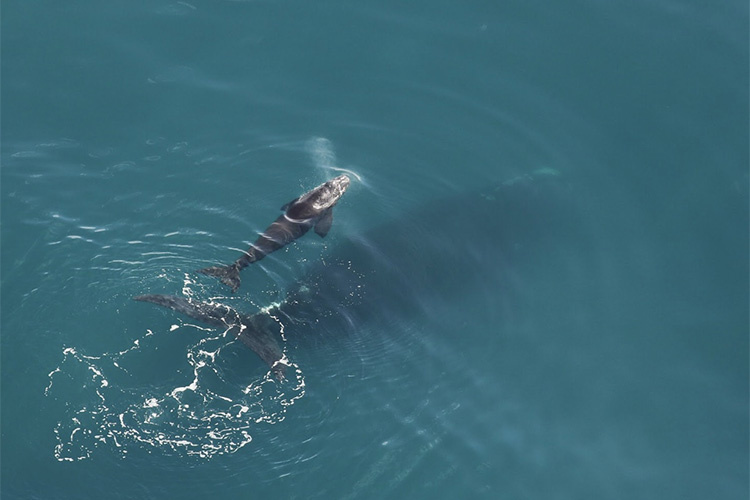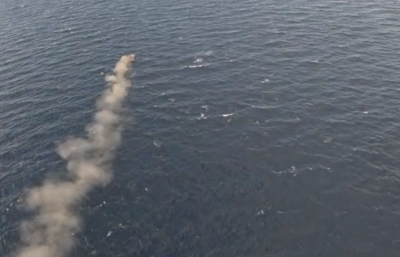A young male North Atlantic right whale found dead off New Jersey June 27 was likely the victim of two vessel strikes weeks apart – bad news for the highly endangered species that for once seemed to be having some luck birthing new calves.
The dead animal spotted around 12:15 p.m. Saturday off Monmouth Beach, N.J., was identified by experts with the New England Aquarium and Florida Fish and Wildlife Conservation Commission as the male calf of a female right whale known as #3560, first seen together of the coast of Georgia in mid-December 2019.
A Coast Guard boat crew towed the carcass to the nearby beach at Sandy Hook, N.J., for a necropsy and then burial by the National Park Service at the Gateway National Recreation Area.
The examination, organized by the Atlantic Marine Conservation Society, Marine Mammal Stranding Center, International Fund for Animal Welfare, and Virginia Aquarium, with volunteers from the University of Pennsylvania Veterinary School, documented evidence the calf had been struck by vessels at least twice.
There were several propeller wounds across the head and chest, with what appeared to be a skeg or rudder injury on the back that may have occurred at the same time.
“Based on observed evidence of healing, those wounds were likely several weeks old, but were serious enough they may have significantly impaired the whale,” according to a summary released by NOAA officials.
“The second vessel collision resulted in a series of propeller wounds and a skeg or rudder wound across the tail stock. Evaluation of these wounds suggests they were inflicted shortly before the animal died and were likely the cause of death,” according to the statement.
The mother and calf had been documented by researchers in the Gulf of Mexico in March, and at that time were reported to have been harassed by boaters violating federal law that requires vessels and aircraft to maintain a distance of 500 yards from the species, NOAA officials said.
“This kind of exposure may have caused the calf to become accustomed to the presence of vessels, which could have contributed to its death,” according to the agency.
It was one of 10 new young counted during the right whales’ calving season off the Southeastern U.S. in 2019-2020. NOAA officials said the mother and calf had last been reported April 6 off Cape Lookout, N.C. – presumably on the annual migration route between the Southeast and New England and Canadian waters.
The adult female mother born in 2005 is now 15 years old and has been tracked by biologists throughout the right whale habitats from Canada to Florida. This was her first calf, NOAA officials said.
Vessel strikes and fishing gear entanglements are major causes of accidental right whale deaths and injuries, with 31 animals dead and 10 seriously injured in Canadian and U.S. waters since 2017, according to NOAA.
With only around 400 right whales surviving, federal officials have treated the situation as an emergency over these past three years. That’s put pressure on the agency and U.S. fishing industry, especially the lobster fleet, to reduce the danger with gear modifications, and brought demands from environmental activists for area closures.
In U.S. waters, NOAA issues right whale alerts to mariners when the animals are spotted moving through an area, and vessels over 65 feet are subject to 10-knot speed limits in designated “seasonal management areas.”
The agency says it has “recently completed an assessment of the right whale vessel speed rule and will soon be releasing a report detailing the conservation effectiveness, economic impacts, navigational safety, and compliance with the rule.
“We are also exploring new ways to use technology such as providing acoustic information to alert vessel operators that right whales are present in an area. The Whale Alert app currently provides real-time alerts to vessel operators about the presence of whales. We work with partners to support this tool and are working to expand communication to vessels.”
Some whale advocates say the federal government needs to take a harder line with mandatory speed limits when whales are sighted around shipping lanes and East Coast port approaches.
“Studies have found that slowing ship speeds to less than 10 knots in areas where these whales may be encountered can reduce the lethality of collisions by 86 percent,” said Whitney Webber, a campaign director with the environmental group Oceana.
The Oceana analysis calculated that 41 percent of 446 vessels tracked during that period exceeded the 10-knot limit for vessels 65 feet and larger.
“The data is clear: when there are mandatory speed limits, ships are more likely to slow down,” Webber said in an Oceana statement Tuesday.
“It’s time for immediate action to protect these whales – NOAA should expand mandatory speed restriction zones and require ships to slow down when whales are present. The future of this species depends on what we do now, and this calf’s death should be a wakeup call that change needs to happen now.”







